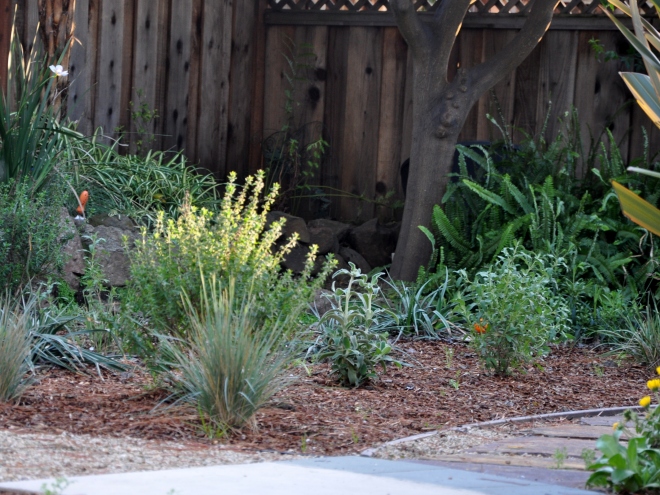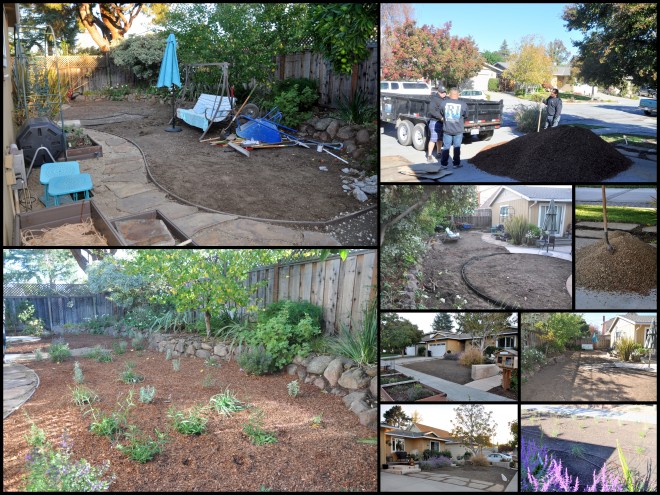There are a number of things to consider when converting lawn to native plants. Economics is one of them. Up front costs are costly if you are unable to do the work yourself. If you live in the Bay Area/Silicon Valley as we do, labor is expensive.
When we bought this house in our thirties, my husband and I did most of the work ourselves. We spent hours removing ivy, digging a faux creek, planting and hauling stones from a quarry in the back of my hatchback. I mowed the lawn with a push-mower, and reluctantly got down on my hands and knees every few weeks to trim the blades of grass away from the curb.
Then life became more complex. I had two boys, three years apart, one requiring a number of early interventions. My husband traveled for one or two weeks each month and often worked long hours beyond a typical day. It made more sense to pay for big jobs then to attempt to do them ourselves. We’re both pretty handy, but we knew our limits.
Now that life is simpler again, I turned my back for five minutes and I’m now in my fifties.
What?
So while we now have more time, we lack the strength and the energy. Between the two of us we have problems with our backs, feet and knees. We used some of our savings instead.
Here’s the math:
Professional landscape design and installation: $7,658
This included labor for hauling of old sod and other debris, site prep, laying of irrigation, planting and mulch. A crew of three worked for five days to complete the project.
Material costs included irrigation pipe and emitters, edging, pea gravel, paving stones for the swing area and plants.
The Santa Clara Water District offered a handsome rebate incentive for converting your lawn. After submitting all the paper work, I received a $2,530 rebate.
This reduced the overall cost by a third, bringing the price down to $5,128.
I am no longer paying a lawn service, saving $1,800 a year in maintenance alone this year or $3,600 over the next 24 months. There will be additional savings in our water bill as well.
Between the rebate and the savings on lawn maintenance, the overall out-of-pocket cost of the conversion is about $1,528. In three years, the project will have paid for itself.
Why replace your lawn? Here’s a handy list published by Green Town Los Altos:
1. Healthier Creeks. Fertilizers, herbicides and pesticides are top polluters in our creeks, killing aquatic life and spreading disease.
2. Less Storm Water Runoff. Deep roots of native plants and trees surrounded by mulch retain more water on site.
3. More Free Time. Native plants don’t require fertilizer, herbicides, pesticides and benefit only from annual or semiannual pruning.
4. Save Water. Lawns require more water than our climate can provide. Reducing our draw of water from the Delta and the Sierras helps maintain their ecosystems.
5. Save Money. All the mowing, fertilizer, herbicides and irrigation of lawns cost a lot of money. Native plants need substantially less effort and money to maintain.
6. Cash for Grass. Santa Clara Valley Water District will pay you up to $2000 to replace your lawn. Note: Sadly, this program is currently out of money, but local citizens can put their name on the waiting list.
7. Good Bugs, Not Bad Bugs. Mosquitoes in our dry summer? There must be a lawn nearby. Frequent watering creates tiny pools just right for mosquitoes to breed. Native plants attract good bugs and birds, ones that eat mosquitoes and other pests.
8. Biodiversity. Other than hardscape, there isn’t a more inhospitable surface to biodiversity than the mono-culture of lawns.
9. Less Greenhouse Gases. Manufacture and transportation of fertilizers, herbicides, pesticides, and mowers has a substantial carbon footprint. Transportation, pumping and treatment of water requires energy. When you save water, you also save energy!
10. Smart Choice. Landscaping with plants that are native to our climate is a smart choice. If you want soft areas for kiddies to roll in, native grasses come in all three flavors: seeds, plugs and sod.
You can read the full article at Green Town Los Altos.
One last thing: An amazing thing has happened since removing the lawn. Now that I’m taking care of the entire garden once again, I feel more connected to my little patch of earth. It’s been a welcome and unexpected gift.




Good info Alys! I hope you help someone make a decision with this.
LikeLike
Thank you, Lisa. It was a long process getting here, but it all feels right now that we are here.
LikeLiked by 2 people
This is such an excellent incentive Alys – but until I read this it had not occurred to me that the poor lawn mowing guys will be losing business left right and centre. I hope they have other options up their sleeves.
LikeLike
That’s a tough one, Pauline, isn’t it? Nick, who used to cut our grass, is also a handyman. I’m able to refer him to clients and have used his services along side client projects. Not everyone has that skill set though.
LikeLike
Great article. We just opened a new museum, and all the landscape is native.
LikeLike
That is terrific news on both fronts!
LikeLiked by 1 person
In the long run, it’s win, win, win getting rid of the lawn. $1.5K+ seems like a large outlay but the rewards you will reap.
I love looking at my lawn-less garden – so much more to see. Like a blackbird hopping along yesterday evening and jumping over the cauliflowers. Priceless!
LikeLike
Helen, I know this subject is near and dear to your heart. You’re living it every day. I’m inspired by all your efforts. Knowing that within three years we’ll have recouped all the costs AND will immediately experience the rewards mentioned above. I don’t miss that grass one bit.
LikeLike
Good for you 🙂
LikeLike
Needless to say I was SUPER stoked to read this. How big is your yard, an acre or less? I’m all about less lawn and I wish Texas had similar incentive programs. People are so proud of green lawns no matter the cost. Will definitely look into ways I can cut out even more grass in my landscape plan. Sharing! And so glad to hear the work is accommodating for your growing pains. 🙂
LikeLiked by 1 person
Thank you, Leilani for reading and for sharing. San Jose really upped their game with this rebate program. It started with seventy-five cents per square foot of replaced sod, then went all the way up to $2 per square foot. We replaced approximately 1,500 square feet of lawn. Property here is astronomical, so our lots are much smaller than yours. We have about 1/4 acre.
If I had a large plot, here is what I think I would do. Depending on your house’s position and the rotation of the sun, I would plant a small orchard to provide summer shade. In front of that I would add shrubs, then in front of that perhaps a seating area with a path to the door. Many nurseries will provide a free plan, or charge a nominal fee (say $100) which they refund or credit toward the cost of plants. The beauty of natives is that they can survive whatever you’ve got (hot sun, heavy rain, etc.). I tried to make my fantasy English garden in San Jose for years. It’s too hot, too dry and not sustainable.
Here is another idea: offer trade. I’ve traded my organizing services in exchange for graphic art design for my business and also for accounting services. Sometimes you can work deals with people who want your services and will trade theirs. You have a big plot to work with so perhaps think of it in zones and proceed from there.
I’m excited to see what your creative mind comes up with.
LikeLike
You have inspired me to action. So many neighbors are replacing lawn with only rock. Makes me sad – when native plants could do the same job – and beautifully.
LikeLike
I’m so happy this inspired you!
I’ve seen some of the all-rock “gardens” and they make no sense. They may save water, but they don’t cool the environment, they don’t attract birds and beneficial insects and most of them are uninspired aesthetically as well. Our beloved earth needs plants.
LikeLiked by 2 people
Here, here!
LikeLike
I loved all the information in this post. You can’t beat a man at his own game. Trying to do the work of professional landscapers is madness and you have penciled out the truth behind that. You win hands down by not doing the work yourselves and torturing your bodies more. You may have let go one landscaper but others got short time work. Everything is always in flux. I was so happy to be done with my lawn and everyone likes the look of the stepables. No fertilizers other than compost and definitely no pesticides. I like that you have so much information to prove your point. Thank you for all of it. Tomorrow is weed pulling day. ;)))
LikeLike
Marlene, thank you for all your support. I found your comment reassuring. Sometimes it’s hard to let go of the idea that we can do it all. I don’t know why. There is NO way we could have done the job that they did. Even the knowledge of products, plants, placement, all of it really. They did an outstanding job and now I can have the pleasure of taking care of it. That feels good. It’s also wonderful to know that I’ve taken another step toward a healthier ecosystem.
So, please tell me what stepables are?
I hope you enjoyed pulling weeds. I’ve been moving around mulch and half-mulch as I call it, things partially broken down but not quite ready for the garden in anticipation of two vegetable beds. Spring like weather continues and we are past any danger of frost.
LikeLike
That’s a great list, and interesting to hear that there are rebates too. I think one of the best reasons is definitely your last point though… that you feel more connected to your garden. 🙂 Enjoy watching it grow and get established now!
LikeLike
Thank you, Cathy!
LikeLiked by 1 person
Wow, love the economics. Make copies of this post and pass them out to your lawn neighbors, ha! 🙂
LikeLike
It’s tempting! Thanks for making me smile, Eliza.
LikeLiked by 1 person